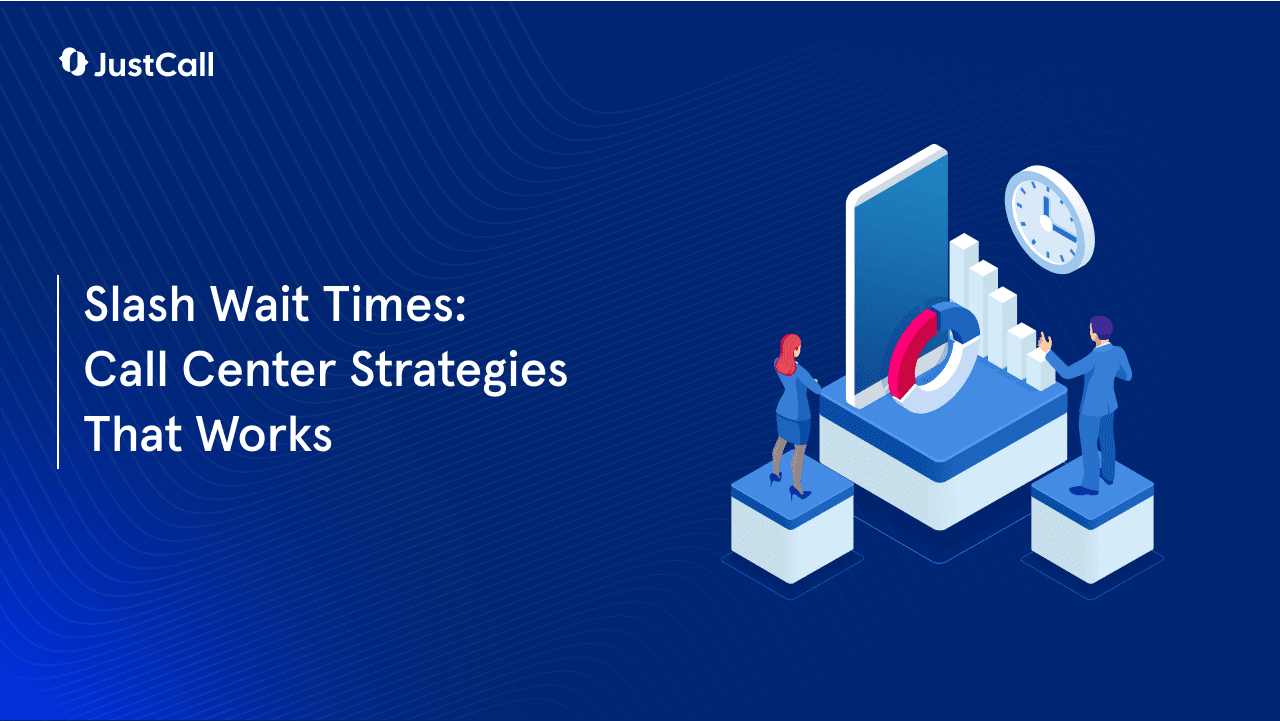Higher average wait time (AWT) almost always leads to higher abandonment rates and lower CSAT scores. No one likes to wait more than a few minutes to connect with a support agent (unless there’s a grave issue that’s worth the wait).
So why does AWT go up at call centers? Usually, because there aren’t enough agents to deal with the volume of calls, the IVR system isn’t optimal, agents are spending too much time on repetitive queries, or there are training and workflow bottlenecks. In some cases, it’s a combination of these factors.
Let’s see how you can solve these challenges and reduce wait times.
What does “average wait time” mean at call centers?
Average wait time (AWT) is the average amount of time it takes for a caller to be routed to an agent, including call queue time.
To calculate your call center’s AWT, add the total queue time and routing time, and divide this with the total number of calls handled.
Average wait time vs average speed of answer
Average speed of answer (ASA) is the time it takes for an agent to pick up a routed call. Unlike AWT, ASA doesn’t include IVR time.
| Average speed of answer = Total time spent in queue before talking to an agent/Total number of calls handled |
| Average wait time = Average speed of answer + IVR time/Total number of calls handled |
In other words, ASA tells you how quickly agents answer a call after the first ring, while AWT tells you the cumulative waiting time for a customer.
Average wait time vs average handling time
Average handling time (AHT) is the time it takes an agent to complete a call. It’s calculated by dividing the total time taken on calls by the total number of calls.
So, while average wait time tells you how efficiently your team is dealing with the volume of queries, average handle time tells you how efficiently agents are dealing with each call.
Three smart ways to reduce average wait time
Here are three effective (but not easy) ways you can reduce the amount of time customers spend waiting to talk to agents.
1. Scale up staffing levels
It’s simple math: if you don’t have enough agents to handle the average call volume, customers are going to wait longer. The obvious solution is to have enough resources in the first place. Here’s how you do this right.
Forecast customer demand
Looking at historical data for how many calls you receive, when you receive them, and the team’s average handling time can help you plan staffing better.
If demand is seasonal, consider investing in part-time resources and giving agents a WFH option (of course, you’ll need a virtual call center setup for this).
Reduce agent attrition
Agent attrition is the rate at which agents leave a call center. High agent attrition can lead to staffing shortages and longer wait times.
The best way to reduce attrition is to give agents all the tools they need to succeed. This means better training, better technology, and a healthy work environment.
2. Find and fill operational gaps
Sometimes, high wait times aren’t a result of inadequate staffing but inadequate skills and/or time management. Agents are either spending too much time on repetitive manual tasks, or they don’t have the right skill set to resolve queries faster. The solution is to find these gaps and fill them.
Workflow gaps
If you’re seeing high AWT despite relatively manageable call queues, it’s possible your agents may be facing technical issues or are juggling too many tasks.
Here, the best solution is to have regular feedback sessions with your team and understand their operational challenges. In most cases, an ideal solution is bringing in reliable tools that come with strong automation capabilities (like a more advanced outbound dialer).
Training gaps
First call resolution (FCR) and average handling time (AHT) can be reliable indicators of training gaps. If an agent has low FCR rates and high AHT, they may not have enough knowledge or the right skill set to effectively resolve queries.
Call scores are also good indicators of training gaps, with consistently low call scores clearly indicating that an agent needs help. Low call scores can also be validated by customer effort scores (CES), which measure how much effort a customer had to put in to get the resolution they were looking for.
3. Implement self-service tools
The best way to clear a call queue faster? Help customers help themselves. Here, technology can be a powerful enabler.
Conversational bots
AI-powered conversational bots can be of two types: support chatbots built into IVR systems and chatbots accessible across customer touch points (website, WhatsApp, social media, mobile app).
Many help desk CRMs and support platforms like Intercom, Drift, HubSpot Service Hub, Freshworks, and Netomi come with built-in support chatbots. Look for similar capabilities in whichever platform you use.
Knowledge bases
Knowledge bases are collections of information that can be accessed by customers to find answers to their questions. Knowledge bases can include articles, FAQs, and other self-service resources.
Knowledge bases are particularly helpful for tech products, where customers want quick and guided solutions without needing to talk to an agent. Knowledge bases can also combine with chatbots to give a more holistic self-serve experience.
Bonus: improve decision-making with conversational intelligence
One effective but underrated way to reduce wait times is getting help from AI
— specifically, conversation intelligence.
Conversation intelligence is when AI scans live calls, call recordings, or transcripts to understand key customer sentiments, topics discussed, and questions asked.
Now, this doesn’t have a direct impact on reducing AWT. However, these AI-generated insights add some predictability to your operations and give agents a realistic view of what to expect from certain types of calls.
For instance, say you run support operations for a cellphone company. There are common software issues that keep coming up on calls, and agents aren’t able to give concrete solutions.
Without conversation intelligence, it may take tens or hundreds of such calls before you realize the need to train agents on solving these common issues. That’s tens or hundreds of customers dissatisfied with the company. With conversation intelligence, you can see trends within a few calls.
What’s an acceptable average wait time?
The short and honest answer? Zero seconds.
“Acceptable wait time” is an oxymoron in the call center business. Any amount of wait time reduces the customer’s happiness quotient (which may not be too high to begin with).
As a call center, your aim is to get to 100% of customers as soon as possible. Keep this as the north star for your operations and optimize processes to get as close as possible.
The problem with the 80/20 rule
Many call centers follow the 80/20 rule to reduce AWT, which means targeting 80% calls answered within 20 seconds.
But there’s a problem with this apparent gold standard of acceptable wait times: what happens to the other 20%? They’re often pushed to the back of the queue. Why? So agents can meet their 20-second target by focusing on the latest calls.
The fact is that your AWT depends heavily on the types of calls being handled.
For instance, a customer may be willing to wait a little longer to find a fix for why their laptop won’t turn on. But the same customer may not be willing to hold for long if they’ve just discovered their bank account has been hacked.
It’s a good idea to set AWT benchmarks based on the nature of calls instead of rushing resolutions for every customer at the cost of satisfaction.
Reduce wait times cautiously
In the pursuit of reducing wait times, call center managers make a critical mistake — sacrificing customer satisfaction for faster response times.
When agents are told to reduce AWT at all costs, their natural response is to bring down the average handling time. In other words, the same number of queries are resolved in less time. This builds pressure, queries aren’t handled well, and CSAT scores go down.
Bringing down wait times as much as possible is ideal, but not at the cost of time that’s necessary to make customers happy.
Training agents better and testing their competency at regular intervals is the only way to find a balance — when agents are skilled and knowledgeable enough, they resolve queries and get to the next call faster.












